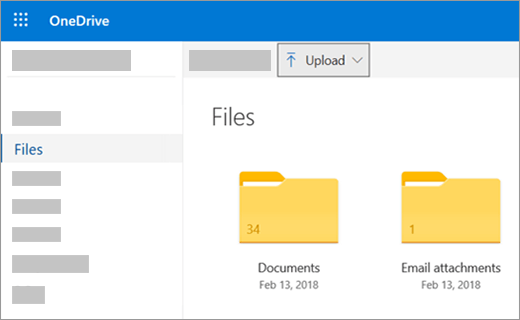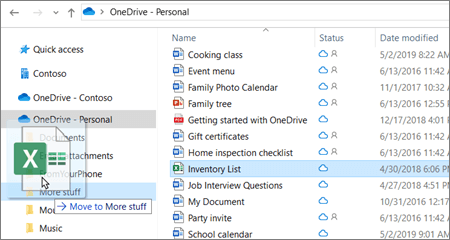How Can We Help?
Using the OneDrive website
Depending on the web browser you use, you can upload files up to 15 GB in size.
Note: For transferring large files or lots of files, we recommend adding the files to the OneDrive desktop app rather than the using Upload button on the website.
- On the OneDrive website sign in with your Microsoft account, and then browse to the location where you want to add the files.
- Select Upload.

- Select the files you want to upload, and then select Open.
Tips:
- You can also drag files from File Explorer straight to your files on the OneDrive website.
- In the Google Chrome or Microsoft Edge browser, you can also upload folders from the Folder option on the Upload menu, or drag folders to the website.
- Learn ways to organize and find photos in OneDrive.
Using File Explorer to copy or move files to OneDrive
You can copy or move files between folders within OneDrive, or from other folders on your computer. When you move files, you’re removing them from your PC and adding them to OneDrive. Drag files from the file list in the right pane to OneDrive in the left pane.

In Windows 10
In new installations of Windows 10 for many eligible users, files save to OneDrive by default in Windows 10, rather than to your PC. This means you can access those files from any device that can connect to the Internet, and they are protected in case your computer is ever damaged. You can change your default save setting anytime. Learn how to set where your files are saved or move your files to OneDrive.
In Windows 8.1 or Windows RT 8.1
You can add files and folders to OneDrive automatically from your PC without having to go to the OneDrive website. Files you add to OneDrive this way can be up to 15 GB in size.
You can save directly to OneDrive from Microsoft Office files (like Word docs and Excel worksheets), PDFs, and other documents. If your PC has a built-in camera, you can automatically save copies of the photos you take directly to OneDrive so you’ll always have a backup. To make sure your PC is set up to save automatically, check your OneDrive settings.
- Swipe in from the right edge of the screen, tap Settings, and then tap Change PC settings. (If you’re using a mouse, point to the lower-right corner of the screen, move the mouse pointer up, click Settings, and then click Change PC settings.)
- For documents, tap or click OneDrive, and then turn on Save documents to OneDrive by default.
- For photos, tap or click Camera roll, and then choose Upload photos at good quality, or for higher resolution copies, choose Upload photos at best quality.
When you move files, you’re removing them from your PC and adding them to OneDrive.
- Tap or click the arrow next to OneDrive and choose This PC.
- Browse to the files you want to move, and then swipe down on them or right-click them to select them.
- Tap or click Cut.
- Tap or click the arrow next to This PC and choose OneDrive to browse to a folder in your OneDrive.
- Swipe in from the top or bottom edge of the screen or right-click to open the app commands, and then tap or click Paste.
Using the OneDrive desktop app
If you have Windows 7, Windows Vista, or a Mac, you can install the free OneDrive desktop app to upload files and folders to OneDrive automatically. Files you upload using the desktop app can be up to 15 GB in size.
Using a mobile app
You can upload files to OneDrive using the OneDrive mobile app for Android, iOS, or Windows Phone. To learn how, see:
From Microsoft Office or Office 365
In any Office document, select File > Save As, choose your OneDrive, and then pick the folder where you want to save the file.

Notes:
- Microsoft might limit the number of files that you can upload to OneDrive each month.
- Please respect copyright and be careful what you share online. Copying or sharing unauthorized materials violates the Microsoft Services Agreement.
